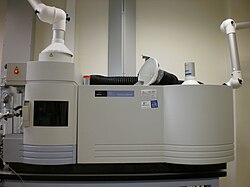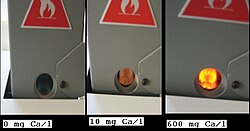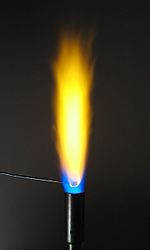150:
must be in a liquid solution. Inductively coupled plasma (ICP) source of the emission consists of an induction coil and plasma. An induction coil is a coil of wire that has an alternating current flowing through it. This current induces a magnetic field inside the coil, coupling a great deal of energy to plasma contained in a quartz tube inside the coil. Plasma is a collection of charged particles (cations and electrons) capable, by virtue of their charge, of interacting with a magnetic field. The plasmas used in atomic emissions are formed by ionizing a flowing stream of argon gas. Plasma's high-temperature results from resistive heating as the charged particles move through the gas. Because plasmas operate at much higher temperatures than flames, they provide better atomization and a higher population of excited states. The predominant form of sample matrix in ICP-AES today is a liquid sample: acidified water or solids digested into aqueous forms. Liquid samples are pumped into the nebulizer and sample chamber via a peristaltic pump. Then the samples pass through a nebulizer that creates a fine mist of liquid particles. Larger water droplets condense on the sides of the spray chamber and are removed via the drain, while finer water droplets move with the argon flow and enter the plasma. With plasma emission, it is possible to analyze solid samples directly. These procedures include incorporating electrothermal vaporization, laser and spark ablation, and glow-discharge vaporization.
127:
90:
1269:
699:
31:
723:
102:
735:
1281:
711:
385:
173:. In traditional arc spectroscopy methods, a sample of the solid was commonly ground up and destroyed during analysis. An electric arc or spark is passed through the sample, heating it to a high temperature to excite the atoms within it. The excited analyte atoms emit light at characteristic wavelengths that can be dispersed with a
149:
Advantages of ICP-AES are the excellent limit of detection and linear dynamic range, multi-element capability, low chemical interference and a stable and reproducible signal. Disadvantages are spectral interferences (many emission lines), cost and operating expense and the fact that samples typically
97:
The sample of a material (analyte) is brought into the flame as a gas, sprayed solution, or directly inserted into the flame by use of a small loop of wire, usually platinum. The heat from the flame evaporates the solvent and breaks intramolecular bonds to create free atoms. The thermal energy also
98:
excites the atoms into excited electronic states that subsequently emit light when they return to the ground electronic state. Each element emits light at a characteristic wavelength, which is dispersed by a grating or prism and detected in the spectrometer.
251:
Stefánsson A, Gunnarsson I, Giroud N (2007). "New methods for the direct determination of dissolved inorganic, organic and total carbon in natural waters by
Reagent-Free Ion Chromatography and inductively coupled plasma atomic emission spectrometry".
181:. However, modern spark sources with controlled discharges can be considered quantitative. Both qualitative and quantitative spark analysis are widely used for production quality control in foundry and metal casting facilities.
1100:
200:
121:
646:
773:
165:
atomic emission spectroscopy is used for the analysis of metallic elements in solid samples. For non-conductive materials, the sample is ground with
417:
17:
389:
991:
177:
and detected. In the past, the spark or arc conditions were typically not well controlled, the analysis for the elements in the sample were
924:
869:
838:
833:
306:
1206:
1024:
886:
1155:
974:
112:
A frequent application of the emission measurement with the flame is the regulation of alkali metals for pharmaceutical analytics.
108:
atomic ions emitting light in a flame displays a brilliantly bright yellow emission at 588.9950 and 589.5924 nanometers wavelength.
1095:
897:
818:
798:
372:
287:
Mermet, J. M. (2005). "Is it still possible, necessary and beneficial to perform research in ICP-atomic emission spectrometry?".
1041:
1019:
766:
669:
457:
1107:
1029:
715:
964:
909:
859:
205:
554:
410:
1191:
943:
759:
354:
331:
1196:
1014:
1211:
1181:
1112:
1046:
739:
1312:
1307:
1140:
931:
828:
676:
442:
190:
1317:
1285:
938:
843:
703:
403:
77:
gives the identity of the element while the intensity of the emitted light is proportional to the number of
1072:
808:
1228:
1067:
1036:
969:
447:
1218:
1160:
1009:
881:
620:
135:
1244:
1223:
864:
523:
513:
346:
139:
986:
307:
http://www.rsc.org/publishing/journals/JA/article.asp?doi=b416511j%7Cformat=%7Caccessdate=2007-08-31
594:
1117:
813:
683:
564:
472:
158:
904:
662:
1273:
1145:
876:
790:
462:
518:
482:
434:
426:
70:
8:
1201:
914:
823:
559:
195:
1249:
1186:
1165:
981:
959:
892:
803:
589:
584:
579:
452:
376:
324:
Atomic absorption, fluorescence, and flame emission spectroscopy: a practical approach
1150:
1077:
1051:
722:
655:
630:
625:
615:
528:
487:
467:
350:
327:
269:
233:
74:
46:
727:
635:
296:
261:
178:
143:
66:
54:
508:
62:
265:
1301:
574:
174:
126:
782:
610:
533:
273:
162:
89:
58:
27:
Analytical method using radiation to identify chemical elements in a sample
343:
Element-specific chromatographic detection by atomic emission spectroscopy
237:
134:
Inductively coupled plasma atomic emission spectroscopy (ICP-AES) uses an
503:
569:
477:
395:
170:
30:
538:
300:
101:
166:
93:
A flame during the assessment of calcium ions in a flame photometer
751:
384:
105:
321:
81:
of the element. The sample may be excited by various methods.
50:
78:
65:
at a particular wavelength to determine the quantity of an
250:
201:
Inductively coupled plasma atomic emission spectroscopy
122:
Inductively coupled plasma atomic emission spectroscopy
34:
Inductively coupled plasma atomic emission spectrometer
130:Inductively coupled plasma atomic emission source
1299:
49:that uses the intensity of light emitted from a
340:
142:at wavelengths characteristic of a particular
767:
411:
115:
839:Vibrational spectroscopy of linear molecules
223:
138:to produce excited atoms and ions that emit
244:
834:Nuclear resonance vibrational spectroscopy
774:
760:
418:
404:
217:
1207:Inelastic electron tunneling spectroscopy
887:Resonance-enhanced multiphoton ionization
322:Reynolds, R. J.; Thompson, K. C. (1978).
975:Extended X-ray absorption fine structure
425:
125:
100:
88:
29:
373:"Atomic Emission Spectroscopy Tutorial"
14:
1300:
670:Analytical and Bioanalytical Chemistry
286:
755:
458:High-performance liquid chromatograph
399:
1280:
710:
206:Laser-induced breakdown spectroscopy
734:
69:in a sample. The wavelength of the
24:
25:
1329:
1192:Deep-level transient spectroscopy
944:Saturated absorption spectroscopy
365:
1279:
1268:
1267:
1197:Dual-polarization interferometry
781:
733:
721:
709:
698:
697:
383:
153:
1212:Scanning tunneling spectroscopy
1187:Circular dichroism spectroscopy
1182:Acoustic resonance spectroscopy
314:
224:Stáhlavská A (April 1973). "".
1141:Fourier-transform spectroscopy
829:Vibrational circular dichroism
443:Atomic absorption spectrometer
280:
191:Atomic absorption spectroscopy
18:Optical Emissions Spectrometer
13:
1:
939:Cavity ring-down spectroscopy
844:Thermal infrared spectroscopy
211:
1073:Inelastic neutron scattering
390:Atomic emission spectroscopy
39:Atomic emission spectroscopy
7:
1134:Data collection, processing
1010:Photoelectron/photoemission
448:Flame emission spectrometer
184:
10:
1334:
1219:Photoacoustic spectroscopy
1161:Time-resolved spectroscopy
136:inductively coupled plasma
119:
116:Inductively coupled plasma
1263:
1245:Astronomical spectroscopy
1237:
1224:Photothermal spectroscopy
1174:
1133:
1126:
1088:
1060:
1002:
952:
852:
789:
693:
644:
603:
547:
524:Ion mobility spectrometry
514:Electroanalytical methods
496:
433:
347:American Chemical Society
266:10.1016/j.aca.2006.09.001
140:electromagnetic radiation
84:
1229:Pump–probe spectroscopy
1118:Ferromagnetic resonance
910:Laser-induced breakdown
684:Analytical Biochemistry
473:Melting point apparatus
341:Uden, Peter C. (1992).
925:Glow-discharge optical
905:Raman optical activity
819:Rotational–vibrational
663:Analytica Chimica Acta
131:
109:
94:
35:
1313:Scientific techniques
1308:Emission spectroscopy
1146:Hyperspectral imaging
555:Coning and quartering
463:Infrared spectrometer
289:J. Anal. At. Spectrom
129:
104:
92:
33:
1318:Analytical chemistry
898:Coherent anti-Stokes
853:UV–Vis–NIR "Optical"
677:Analytical Chemistry
519:Gravimetric analysis
483:Optical spectrometer
427:Analytical chemistry
392:at Wikimedia Commons
71:atomic spectral line
1202:Hadron spectroscopy
992:Conversion electron
953:X-ray and Gamma ray
860:Ultraviolet–visible
326:. New York: Wiley.
196:Atomic spectroscopy
1250:Force spectroscopy
1175:Measured phenomena
1166:Video spectroscopy
870:Cold vapour atomic
590:Separation process
585:Sample preparation
169:powder to make it
132:
110:
95:
36:
1295:
1294:
1259:
1258:
1151:Spectrophotometry
1078:Neutron spin echo
1052:Beta spectroscopy
965:Energy-dispersive
749:
748:
631:Standard addition
626:Internal standard
616:Calibration curve
529:Mass spectrometry
488:Spectrophotometer
468:Mass spectrometer
453:Gas chromatograph
388:Media related to
75:emission spectrum
47:chemical analysis
45:) is a method of
16:(Redirected from
1325:
1283:
1282:
1271:
1270:
1131:
1130:
1042:phenomenological
791:Vibrational (IR)
776:
769:
762:
753:
752:
737:
736:
725:
713:
712:
701:
700:
636:Isotope dilution
420:
413:
406:
397:
396:
387:
380:
375:. Archived from
360:
345:. Columbus, OH:
337:
309:
304:
301:10.1039/b416511j
284:
278:
277:
254:Anal. Chim. Acta
248:
242:
241:
221:
21:
1333:
1332:
1328:
1327:
1326:
1324:
1323:
1322:
1298:
1297:
1296:
1291:
1255:
1233:
1170:
1122:
1084:
1056:
998:
948:
848:
809:Resonance Raman
785:
780:
750:
745:
689:
640:
599:
543:
492:
435:Instrumentation
429:
424:
371:
368:
363:
357:
334:
317:
312:
285:
281:
249:
245:
222:
218:
214:
187:
156:
124:
118:
87:
28:
23:
22:
15:
12:
11:
5:
1331:
1321:
1320:
1315:
1310:
1293:
1292:
1290:
1289:
1277:
1264:
1261:
1260:
1257:
1256:
1254:
1253:
1247:
1241:
1239:
1235:
1234:
1232:
1231:
1226:
1221:
1216:
1215:
1214:
1204:
1199:
1194:
1189:
1184:
1178:
1176:
1172:
1171:
1169:
1168:
1163:
1158:
1153:
1148:
1143:
1137:
1135:
1128:
1124:
1123:
1121:
1120:
1115:
1110:
1105:
1104:
1103:
1092:
1090:
1086:
1085:
1083:
1082:
1081:
1080:
1070:
1064:
1062:
1058:
1057:
1055:
1054:
1049:
1044:
1039:
1034:
1033:
1032:
1027:
1025:Angle-resolved
1022:
1017:
1006:
1004:
1000:
999:
997:
996:
995:
994:
984:
979:
978:
977:
972:
967:
956:
954:
950:
949:
947:
946:
941:
936:
935:
934:
929:
928:
927:
912:
907:
902:
901:
900:
890:
884:
879:
874:
873:
872:
862:
856:
854:
850:
849:
847:
846:
841:
836:
831:
826:
821:
816:
811:
806:
801:
795:
793:
787:
786:
779:
778:
771:
764:
756:
747:
746:
744:
743:
731:
719:
707:
694:
691:
690:
688:
687:
680:
673:
666:
659:
651:
649:
642:
641:
639:
638:
633:
628:
623:
618:
613:
607:
605:
601:
600:
598:
597:
592:
587:
582:
577:
572:
567:
562:
557:
551:
549:
545:
544:
542:
541:
536:
531:
526:
521:
516:
511:
509:Chromatography
506:
500:
498:
494:
493:
491:
490:
485:
480:
475:
470:
465:
460:
455:
450:
445:
439:
437:
431:
430:
423:
422:
415:
408:
400:
394:
393:
381:
379:on 2006-05-01.
367:
366:External links
364:
362:
361:
355:
338:
332:
318:
316:
313:
311:
310:
279:
243:
215:
213:
210:
209:
208:
203:
198:
193:
186:
183:
155:
152:
120:Main article:
117:
114:
86:
83:
26:
9:
6:
4:
3:
2:
1330:
1319:
1316:
1314:
1311:
1309:
1306:
1305:
1303:
1288:
1287:
1278:
1276:
1275:
1266:
1265:
1262:
1251:
1248:
1246:
1243:
1242:
1240:
1236:
1230:
1227:
1225:
1222:
1220:
1217:
1213:
1210:
1209:
1208:
1205:
1203:
1200:
1198:
1195:
1193:
1190:
1188:
1185:
1183:
1180:
1179:
1177:
1173:
1167:
1164:
1162:
1159:
1157:
1154:
1152:
1149:
1147:
1144:
1142:
1139:
1138:
1136:
1132:
1129:
1125:
1119:
1116:
1114:
1111:
1109:
1106:
1102:
1099:
1098:
1097:
1094:
1093:
1091:
1087:
1079:
1076:
1075:
1074:
1071:
1069:
1066:
1065:
1063:
1059:
1053:
1050:
1048:
1045:
1043:
1040:
1038:
1035:
1031:
1028:
1026:
1023:
1021:
1018:
1016:
1013:
1012:
1011:
1008:
1007:
1005:
1001:
993:
990:
989:
988:
985:
983:
980:
976:
973:
971:
968:
966:
963:
962:
961:
958:
957:
955:
951:
945:
942:
940:
937:
933:
930:
926:
923:
922:
921:
918:
917:
916:
913:
911:
908:
906:
903:
899:
896:
895:
894:
891:
888:
885:
883:
882:Near-infrared
880:
878:
875:
871:
868:
867:
866:
863:
861:
858:
857:
855:
851:
845:
842:
840:
837:
835:
832:
830:
827:
825:
822:
820:
817:
815:
812:
810:
807:
805:
802:
800:
797:
796:
794:
792:
788:
784:
777:
772:
770:
765:
763:
758:
757:
754:
742:
741:
732:
730:
729:
724:
720:
718:
717:
708:
706:
705:
696:
695:
692:
686:
685:
681:
679:
678:
674:
672:
671:
667:
665:
664:
660:
658:
657:
653:
652:
650:
648:
643:
637:
634:
632:
629:
627:
624:
622:
621:Matrix effect
619:
617:
614:
612:
609:
608:
606:
602:
596:
593:
591:
588:
586:
583:
581:
580:Pulverization
578:
576:
573:
571:
568:
566:
563:
561:
558:
556:
553:
552:
550:
546:
540:
537:
535:
532:
530:
527:
525:
522:
520:
517:
515:
512:
510:
507:
505:
502:
501:
499:
495:
489:
486:
484:
481:
479:
476:
474:
471:
469:
466:
464:
461:
459:
456:
454:
451:
449:
446:
444:
441:
440:
438:
436:
432:
428:
421:
416:
414:
409:
407:
402:
401:
398:
391:
386:
382:
378:
374:
370:
369:
358:
356:0-8412-2174-X
352:
348:
344:
339:
335:
333:0-470-26478-0
329:
325:
320:
319:
308:
302:
298:
294:
290:
283:
275:
271:
267:
263:
259:
255:
247:
239:
235:
231:
228:(in German).
227:
220:
216:
207:
204:
202:
199:
197:
194:
192:
189:
188:
182:
180:
176:
175:monochromator
172:
168:
164:
160:
154:Spark and arc
151:
147:
145:
141:
137:
128:
123:
113:
107:
103:
99:
91:
82:
80:
76:
72:
68:
64:
60:
56:
52:
48:
44:
40:
32:
19:
1284:
1272:
1252:(a misnomer)
1238:Applications
1156:Time-stretch
1047:paramagnetic
919:
865:Fluorescence
783:Spectroscopy
738:
726:
714:
702:
682:
675:
668:
661:
654:
647:publications
611:Chemometrics
595:Sub-sampling
534:Spectroscopy
377:the original
342:
323:
315:Bibliography
292:
288:
282:
260:(1): 69–74.
257:
253:
246:
232:(4): 238–9.
229:
225:
219:
157:
148:
133:
111:
96:
42:
38:
37:
824:Vibrational
740:WikiProject
604:Calibration
565:Dissolution
504:Calorimetry
179:qualitative
1302:Categories
1030:Two-photon
932:absorption
814:Rotational
645:Prominent
570:Filtration
497:Techniques
478:Microscope
212:References
171:conductive
1108:Terahertz
1089:Radiowave
987:Mössbauer
539:Titration
295:: 11–16.
226:Pharmazie
1274:Category
1003:Electron
970:Emission
920:emission
877:Vibronic
704:Category
560:Dilution
548:Sampling
274:17386476
185:See also
167:graphite
1286:Commons
1113:ESR/EPR
1061:Nucleon
889:(REMPI)
716:Commons
656:Analyst
575:Masking
238:4716605
144:element
73:in the
67:element
1127:Others
915:Atomic
728:Portal
353:
330:
272:
236:
106:Sodium
55:plasma
1068:Alpha
1037:Auger
1015:X-ray
982:Gamma
960:X-ray
893:Raman
804:Raman
799:FT-IR
305:|url=
159:Spark
85:Flame
79:atoms
63:spark
61:, or
51:flame
351:ISBN
328:ISBN
270:PMID
234:PMID
1096:NMR
297:doi
262:doi
258:582
163:arc
161:or
59:arc
43:AES
1304::
1101:2D
1020:UV
349:.
293:20
291:.
268:.
256:.
230:28
146:.
57:,
53:,
775:e
768:t
761:v
419:e
412:t
405:v
359:.
336:.
303:.
299::
276:.
264::
240:.
41:(
20:)
Text is available under the Creative Commons Attribution-ShareAlike License. Additional terms may apply.



